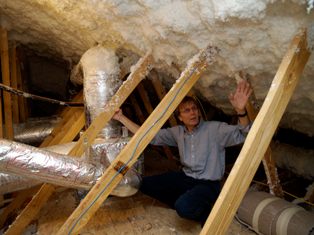With Lowered Tax Breaks for Energy Efficiency, Media and Public Attention Are Likely to Wane

The tax breaks put into place by the 2009 Economic Recovery Act stimulated a sharp rise in news and consumer attention to a range of energy efficiency home improvements, providing the incentive for homeowners with the resources, time, and motivation to take advantage of cost-saving retrofits and increasing–at least temporarily–the demand for these services within the housing and building industry.
But as Ken Harvey discussed in a column at the Washington Post yesterday, with these tax breaks expiring, what replaces them is not nearly as enticing to consumers, meaning that news and public attention to household energy efficiency improvements is likely to wane.
As Harvey summarizes, the omnibus tax deal signed into law by Obama this December reduced tax credits for energy-efficient remodeling from the current 30 percent of an improvement’s cost ($1,500 maximum per taxpayer) to a 10 percent credit, with a $500 maximum for expenditures on insulation materials, exterior windows and storm doors, skylights and metal and asphalt roofs that resist heat gain. There are also now dollar limits on specific improvements that had been eligible for the 30% tax break. According to Harvey, these include:
…a $150 tax credit limit on the costs of energy-efficient natural gas, propane and oil furnaces, and hot water boilers, plus a $300 credit limit on the costs of central air-conditioning systems, electric heat pump water heaters, biomass stoves for heating or water heating, electric heat pumps, and natural gas and propane water heaters. The new law also limits allowable tax credits available for energy-efficient windows installed during 2011 to a total of $200, compared with the previous $1,500. On top of that, it prohibits taxpayers who have taken total tax credits in past years exceeding $500 from claiming any additional credits on energy-conservation projects they undertake in the coming year.
But the biggest impact will likely be on public awareness of the advantages and need for home energy improvements. The Recovery Act generated a significant spike in news media attention to home energy improvement, especially in local newspaper and TV coverage related to consumer trends, home improvement, business, and real estate, beats that capture audiences who may not otherwise pay close attention to the climate change or energy debate. Google Trends shows the correlated rise in news attention and information seeking among Internet users in the United States from 2008, a year of very limited public information seeking, to the surge in information seeking that occurred in 2009 and 2010.
As Harvey quotes several industry specialists, the new tax breaks are not nearly as appealing or motivating to builders or consumers, and as a result are unlikely to stimulate nearly as much continued local news attention, information seeking, public awareness, learning, and consumer action:
The net effect of all this [i.e. the reduced tax incentives], say home-building and remodeling experts, will be to severely diminish consumers’ interest in energy-efficient home improvements. Donna Shirey, chairman of the Remodelers Council of the National Association of Home Builders and president of a contracting firm in the Seattle area, said the gutting of energy-efficiency credits “is a big step backward. It’s bad for the environment, bad for consumers and, of course, bad for jobs in our industry. We’re heading the wrong way here, sending absolutely the wrong message.”
David Merrick, president of Merrick Design and Build in Kensington and government affairs chairman of the National Association of the Remodeling Industry, said the $1,500 credit, which expired Dec. 31, has had the effect of “opening people’s eyes to energy-conserving features they could incorporate” into home improvement projects that they otherwise might have ignored.
The credit, he said, provided incentives for homeowners to ask about the long-term savings they could achieve by upgrading insulation, installing high-efficiency windows and the like.
Now, with a $500 credit maximum, Merrick said, “I doubt that many people will see things that way. They’ll just go back to remodeling their bathroom or kitchen,” and will be less willing to spend extra money on energy-saving improvements as part of the project.
Merrick added that from a contractor’s point of view, “the $500 credit will be virtually worthless – not worth the paper it will take us to process” the documentation required by the government.
Barb Friedman, Merrick’s vice chairman on the remodelers committee and president of Oswego Design and Remodeling in Lake Oswego, Ore., noted in an interview that 70 percent of all housing units in the country are 30 years or older and that most have significant energy inefficiencies caused by their age alone.
“The $1,500 credit was a step in the right direction,” a step toward providing owners financial incentives to reduce some of these inefficiencies, for their benefit and the environment as well. “But $500 is more like a drop in the bucket,” she said.
The Alliance to Save Energy, a coalition of business, government, environmental and consumer groups that lobbied unsuccessfully for retention of the credits as they were, said the cutbacks in the homeowner credit program will be felt far beyond the remodeling industry.
Alliance President Kateri Callahan said: “We’re sorely disappointed that Congress did not see fit to make the incentives more generous. That would have increased their use by consumers, to the benefit of our economy, energy security and environment.”
What is the outlook for restoration of the credits in the new Congress? Call it lights out. There’s virtually no chance of another big tax bill supporting energy-efficiency improvements moving ahead on Capitol Hill in the near future.
See Also:
Nisbet, M.C. & Kotcher, J. (2009). A Two Step Flow of Influence? Opinion-Leader Campaigns on Climate Change. Science Communication, 30, 328-358. (PDF).




